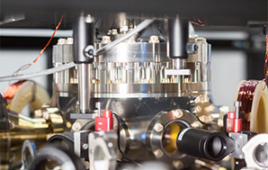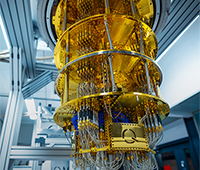TACC Releases Software to Drive Large-scale Tiled Displays
The Texas Advanced Computing Center (TACC) at The University of Texas at Austin has released a new open-source software package called DisplayCluster that is used to drive large-scale tiled displays and allows scientists to interact and view high-resolution imagery and video up to gigapixels in size.
Large-scale tiled displays are increasingly used by scientific communities for their effectiveness in visualizing immense data sets. Whether it is a microbiology professor teaching about viruses in the bloodstream, a doctor reviewing high-resolution medical scans, or an art student studying the brush strokes in Van Gogh’s Starry Night — all of these domains use large, high-resolution displays to visualize information that may not be apparent on a smaller, lower-resolution screen, thereby improving comprehension.
TACC staff members began development of this software during a collaborative project with UT’s College of Education (COE) to construct a visualization lab. During this process, TACC staff members Greg P. Johnson and Brandt Westing experienced cross-platform challenges and complications due to the fact that TACC’s visualization lab is driven primarily by Linux systems and the COE is a Mac-based environment.
“We developed DisplayCluster to meet our commitments and obligations for the COE visualization lab,” Greg P. Johnson, TACC visualization specialist said. “Yet, we knew it would meet the ever-growing needs of the open-science community as well.”
For several years, TACC’s visualization team has been using the Scalable Adaptive Graphics Environment (SAGE) to run Stallion, the center’s showcase visualization cluster and one of the highest resolution tiled displays in the world. SAGE is mostly open source; yet, recent development is closed-source, which makes it difficult for users to modify, Johnson said.
“We developed DisplayCluster with features lacking in other tiled display software packages to make it a more productive and useful environment,” Johnson said. “We created a user-friendly software package that will work in both Mac and Linux-based systems, and will remain open source for public updates and future tiled displays.”
DisplayCluster software features:
• Cross-Platform Applicability. Works in both Linux and Mac OSX environments.
• Media Viewing. Ultra-high resolution video content and imagery.
• Pixel Streaming. Allows desktops or applications to stream data from remote sources directly to the tiled display.
• Multiple Interactive Interfaces. Users can simultaneously interact with the display using devices such as:
o Joysticks
o Gamepad controllers
o Touch-enabled devices: iPhone, iPad, iTouch, Android devices
• Microsoft Kinect: interaction via body gestures
• Scriptability. Fully scriptable via a Python API (application programming interface).
DisplayCluster has garnered interest from scientists and researchers around the country. Some, like Professor Yusheng Feng, director of the SiViRT Computation Center and responsible for the National Science Foundation-sponsored Advanced Visualization Lab, both at The University of Texas at San Antonio (UTSA), has recently switched from SAGE/MagicCarpet software drivers to DisplayCluster to run his large, tiled displays.
“We had tremendous challenges in running our visualization wall before we switched to DisplayCluster,” Feng said. “The performance and functionalities improved exponentially after the installation, which took less than a day. I am told that UTSA is the first beta-test site outside of UT Austin, and we are very pleased to have such an opportunity.”
“We’re currently working on providing advanced users writing their own visualization applications with a very simple API so that all they have to do is add a few lines to their code, and their applications will run on their tiled displays in full native resolution,” Johnson said.
Future versions of DisplayCluster will be released with new features. The software package was developed by members of TACC’s visualization and data analysis group, Greg P. Johnson, Greg Abram and Brandt Westing.
Kelly Gaither, TACC’s director of visualization, said: “In addition to providing advanced visualization resources and services to enable the research efforts of our users, we are involved in a wide range of research and development projects aimed at next-generation visualization technologies.”
To download DisplayCluster, visit: http://www.tacc.utexas.edu/tacc-projects/displaycluster
To learn more about other TACC research and development projects, visit: http://www.tacc.utexas.edu/tacc-projects



